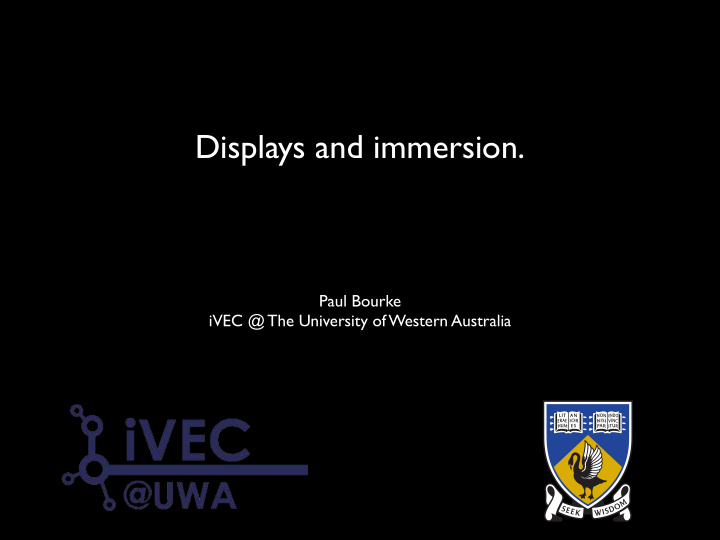



Displays and immersion. Paul Bourke iVEC @ The University of Western Australia
Introduction • Immersion, “being there” ... around the extent to which one feels like one is really within an imperfectly mediated world (Mimetic Immersion). • Werner Wolf describes immersion as : “... a feeling, with variable intensity, of being imaginatively and emotionally immersed in a represented world and of experiencing this world in a way similar (but not identical) to real life”. • The focus for data visualisation is often around the extent to the digital delivery engages/ leverages the human visual system, and other senses. • In the case of vision this is relates to: - stereopsis (depth perception arising from images from two positions, our eyes) - peripheral vision (for humans about 170 degrees by 120 degrees) - fidelity (spatial and temporal resolution) • How do we rate the degree to which a display can support immersion?
Visualisation laboratory, UWA • Displays of different types, how to rate them? None are perfect. • Can do this qualitatively (user surveys) but would be helpful to have a quantitative basis. 4K iDome Tiled display Multiple high resolution panels Stereo head tracked panels
Plenoptic function: Light field • Plenoptic: (optics) Of or relating to all the light, travelling in every direction in a given space. • The “light field” is the infinity of 3D points through which innumerable light rays diverge and converge. • The part of the light field we observe (in one eye) are the two spherical images located at the position of our eyes. • The plenoptic function is a 7 dimensional function of position: (3 variables), polar angle (2 variables), wavelength and time. Converging rays arriving at any single point of the light field can be imagined as a spherical image of the world seen from that single position.
Requirements • An ideal immersive display needs to represent this light field intensity “i” • Any (current) display is only an approximation of the light field, display artefacts include: Display artefact Display Feature Limitation of L() Frame Limited field of view Pixels Resolution False colour Colour gamut Colour banding Colour depth i Low contrast / brightness Dynamic range i Noise Signal to noise t Lag Latency t Refresh rate / flicker / jitter Frame rate McGinity
Case 1: 4K desktop display Light field parameter Comments Rating Not stereo3D enabled. x,y,z No head tracking. Framed view, angular field is limited. High pixel resolution so low angular discretisation Standard display technology capabilities, would be improved by HDR display. Standard display technology of t 60Hz Standard display technology i capabilities. Good Not ideal but current state of technology Not ideal and limited by nature of system Poor
Tiled display
Tiled display Light field parameter Comments Rating Not stereo3D enabled. x,y,z No head tracking. Wider field of view by standing closer, still framed. High pixel resolution so low angular discretisation Standard display technology colour capabilities. Standard display technology of t 60Hz Standard display technology i capabilities.
iDome • 180 degree field of view, single person dome.
iDome Light field parameter Comments Rating Not stereo3D enabled. x,y,z No head tracking. Largely removes framing of human visual field. Most common variation has modest resolution, so high angular discretisation. Standard projector colour specifications. t Standard for projector, 60Hz Standard for projector but i degraded by interrefections and imperfect optics.
Oculus Rift • One of a number of low cost head mounted displays on the market.
Oculus Rift Light field parameter Comments Rating Stereo support, position and x,y,z view direction tracking. Entire human visual field not engaged. Low resolution, so high angular discretisation. Standard projector colour specifications. t Standard for panels. t Poor head tracking latency. i Standard for panels.
Stereo3D tiled display
Stereo3D tiled display Light field parameter Comments Rating Stereo support and position x,y,z tracking. Significant portion of the human visual field engaged when close. High resolution so low angular discretisation. Better colour than standard panels. t Standard for panels of 60Hz. Head tracking latency. t Stereo refresh of 30Hz i Standard for panels.
Conclusion and future work • Have introduced a formal method for rating display technologies by the extent that they represent the plenoptic function. • This relates specifically to how they might support mimetic immersion (mimicking the real world) and maximise visualisation processes by leveraging the characteristics of the human visual system. • User studies of immersion and visualisation experience can be compared to determine the relative importance of the parameters in the plenoptic function.
Recommend
More recommend